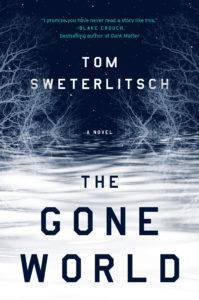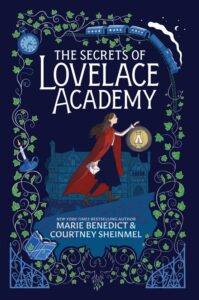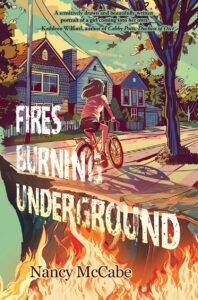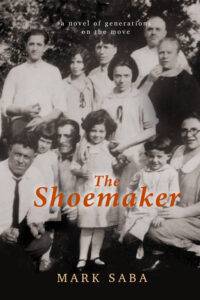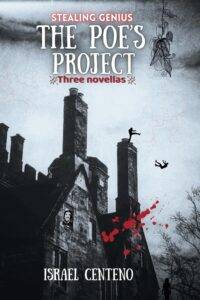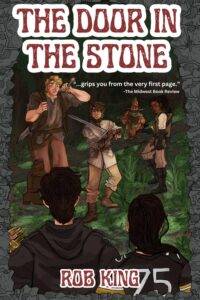Tom Sweterlitsch is the author of Tomorrow and Tomorrow and The Gone World. He’s co-written several short films with Director Neill Blomkamp for Oats Studios — and Blomkamp will be directing the adaptation of The Gone World (check out Sweterlitsch and Blomkamp in conversation on EW.com). Sweterlitsch has a Master’s Degree in Literary and Cultural Theory from Carnegie Mellon and worked for twelve years at the Carnegie Library for the Blind and Physically Handicapped.
Littsburgh is thrilled to be able to share an excerpt from The Gone World — and to help us celebrate, his publisher has created a sweepstakes for our readers… so be sure to enter for your chance to win!
From the Publisher: “Inception meets True Detective in this science fiction thriller of spellbinding tension and staggering scope that follows a special agent into a savage murder case with grave implications for the fate of mankind…”
Don’t miss out: Sweterlitsch will be in conversation with Daniel Lowe at Riverstone Books on February 22nd!
“I promise you have never read a story like this.” —Blake Crouch, New York Times bestselling author of Dark Matter
One
“Special Agent Shannon Moss?”
She didn’t recognize the man’s voice, though she recognized the drawl on the vowels. He’d grown up around here, West Virginia, or Pennsylvania — rural.
“This is Moss,” she said.
“A family’s been killed.” A quaver in his voice. “Washington County dispatch logged the 911 a little after midnight. There’s a missing girl.”
Two a.m., but the news was like an ice bath. She was fully awake now.
“Who am I speaking with?”
“Special Agent Philip Nestor,” he said. “FBI.”
She turned on her bedside lamp. Cream-colored wallpaper patterned with vines and cornflower-blue roses covered her bedroom walls. She traced the lines with her eyes, thinking.
“Why my involvement?” she asked.
“My understanding’s that our SAC communicated with HQ and they instructed him to involve you,” said Nestor. “They want NCIS assistance. Our primary is a Navy SEAL.”
“Where?”
“Canonsburg, on a street called Cricketwood Court, just off Hunter’s Creek,” he said.
“Hunting Creek.”
She knew Hunting Creek, Cricketwood Court-her best friend growing up had lived on that street, Courtney Gimm. The image of Courtney’s face floated from Moss’s memory like ice surfacing through water.
“How many victims are we dealing with?”
“Triple homicide,” said Nestor. “It’s bad. I’ve never –”
“Slow down.”
“I’d seen some kids hit by a train once, but nothing like this,” he said.
“Okay,” said Moss. “You said the call came in after midnight?”
“A little later,” said Nestor. “A neighbor heard commotion, finally called the police –”
“Do you have someone speaking with the neighbor?”
“One of our guys is with her now,” he said.
“I’ll make it there in a little over an hour.”
She gained her equilibrium before attempting to stand — her right leg still the lean, muscled leg of an athlete, but her left terminated in a conical mid-thigh stump, the end muscle and flesh there wrapped like a fold-over pastry. She’d lost her leg years ago when she’d been crucified in the deep winter of the Terminus — a transfemoral amputation, the Navy surgeons having cut away the part of her that had gone gangrenous. When she stood, she perched on her single foot like a long-legged shore bird, rocking on the pads of her toes for balance. Her crutches were within reach, Lofstrand crutches she kept propped in the gap between her bed and nightstand. She slipped her forearms through the cuffs and gripped the handles, propelling herself through her bedroom, a cluttered mess of clothes and magazines, loose CDs, empty jewel cases-slipping hazards her occupational therapist had warned her against.
Cricketwood Court . . .
A shiver passed over Moss at the thought of returning. She and Courtney had been like sisters through middle school, freshman year — closer than sisters, inseparable. Moss’s memories of Courtney were the sweetest essence of childhood summers — endless days spent poolside, roller coasters at Kennywood, splitting cigarettes down by Chartiers Creek. Courtney had died their sophomore year, murdered in a parking lot for the few dollars she’d had in her purse.
Headline News on the bedroom set while she dressed. She applied antiperspirant to her residual limb, then nestled her polyurethane liner against the blunt edge of her thigh, rolling it to her hip as if she were rolling on a nylon stocking. She smoothed the rubbery sleeve of any air bubbles that might have accrued against her skin. The prosthesis was an Ottobock C-Leg, a prototype — a computerized prosthesis originally designed for wounded soldiers. Moss slid her thigh into the socket and stood, the volume of her thigh forcing out air from the carbon cuff, vacuum-sealing the prosthesis. The C-Leg made her feel as if her skeleton were exposed — a steel shank instead of a shin. She wore slacks, a blouse the color of pearls. She holstered her service weapon. She wore a tailored suede jacket. A last glance at television: Dolly skulking in her hay-strewn pen, Clinton touting the newly signed human-cloning ban, promos for the NBA on NBC, Jordan versus Ewing.
“Jesus Christ . . .”
The house Moss remembered from her childhood was as if superimposed over the house as it stood-two films playing concurrently, a memory and a crime scene. Courtney’s family had long since moved from here, and Moss never thought she would set foot within her old friend’s house again, certainly not under these circumstances. A two-story end unit, the other houses in its row lined up like mirror reflections, each with a driveway, a petite garage, each front stoop lit by a single porch light, the façades identical down the line, brick topped by white vinyl. Growing up, Moss had spent more time here than at her own house, it seemed-she still remembered the Gimms’ old phone number. An oily sensation of one reality oozing into another, like a yolk pouring through a crack in its shell. She took a swig of coffee from her thermos and rubbed her eyes as if to wake herself, to convince herself that this coincidence of houses was real, that she wasn’t caught dreaming. A coincidence, she told herself. There used to be a flowering dogwood in the front yard that had since been hacked down.
Moss slowed her pickup at a sheriff’s blockade, and a deputy approached her window, a middle-aged gut and Chaplinesque mustache that would have been humorous except for the weariness weighing in his eyes. He tried to get her to turn her truck around until she rolled down her window and showed identification.
“What is that?” he asked.
“Naval Criminal Investigative Service,” she said, accustomed to explaining her agency’s initials. “Federal agent. We’re interested in a possible military connection. How bad is it?”
“My buddy was in there earlier and told me this is the worst he’s ever seen, just the goddamned worst,” he said, his breath stale with coffee. “Says there’s not much left of them.”
“Reporters been around?”
“Not yet,” he said. “We were told some news vans are on their way down from Pittsburgh. I don’t think they know what they’ll find. Quiet otherwise. Come on through.”
A lace of police tape cordoned off the lawn and driveway, stretching from a lamppost and looping around the house’s wrought-iron stoop railing. Some of the forensic technicians huddled near the garage, a smoke break. They watched Moss approach without the casual chauvinism or bald stares she sometimes encountered at scenes — their eyes were haunted tonight, glancing her way as if they pitied her for what she was about to endure.
The doorway was draped with a plastic tarp, but the smells of the house assaulted her once she ducked through, the cloying tang of blood and bright rot and shit mingled with chemical stenches of the techs’ solutions, the collection kits and ethanol. The odors seeped into her, a metallic tinge from the blood, her saliva immediately coppery as if she’d sucked on pennies. Criminalists in Tyvek crowded the foyer, busy with evidence preservation, photography. A nervous anticipation roiled Moss in the moments before her first view of a new crime scene; once she turned the corner and saw what she was dealing with, however, her nervousness dissipated, replaced by an urgent and sorrowful compulsion to reassemble the broken pieces as quickly as possible.
A boy and a woman lay on the floor, their faces smeared away in a mince of brain and blood and whorls of bone. Flannel pants on the boy, a jersey for a nightshirt — ten or eleven years old, Moss guessed. The woman’s nightgown was filthy with blood, her bare legs shading to plum where lividity had discolored her. Both had voided their bowels, the floor so sopped that shit and standing blood had pooled in the uneven runnels of the carpeting. The odors gagged her. The smells of the boy and his mother degraded them, she thought, their humanity debased by sewage stink and formlessness.
Moss had long ago learned the dissociative technique of viewing bodies through different lenses, divorcing the mutilation as much as possible from the personalities they once were — seeing her colleagues around her through the lens of humanity, seeing the bodies through the lens of forensics. Moss objectified the corpses. The kill stroke for the woman had been one of two blows to her head, either to her left zygomatic or to the parietal on the same side. The woman’s left pupil had dilated to a wide black saucer. Moss noticed that the boy’s fingernails had been removed, all of them. And his toenails, too, it looked like. She checked the woman and found that her nails had been removed as well. Someone — a man, no doubt — had killed these people, then knelt in the gore to pluck their nails from them. Or had he taken their nails before he’d killed them? Why had he done that? One of the technicians ran lengths of thread from the blood spatter on the ceiling and walls, creating a web of thread that delineated an area of convergence — it looked like the victims had been on their knees when they were struck, an execution. The room they had died in was bland, tasteless — nothing like the room Moss had once known, the comfortable, cavelike rec room kept by her best friend’s family. Oatmeal tones now, track lighting. Nothing on the walls, no artwork, no photographs; the room didn’t look lived in, it looked staged for resale.
“Shannon Moss?”
One of the men in Tyvek had paused in his work. Bloodshot eyes, nearly crimson, his dark skin ashen, VapoRub daubed beneath his nostrils in twin greasy streaks.
“Special agent, NCIS,” she said.
He crossed the living room on stainless-steel risers the investigators used like stepping-stones over the blood. He chewed gum, said, “William Brock, Special Agent in Charge. Let’s talk.”
Brock led her through the narrow kitchen, the few men gathered there no longer wearing their Tyvek, their shirts and ties rumpled from hours of work, their faces wan with sleeplessness. Brock, however, seemed tireless — like he would charge bullish until this killer was caught. Angry, almost scowling as he led Moss, as if personally offended by what had happened here. He was sizeable, his voice a resonant baritone in a room of hushed voices.
“Right through here, in this little den,” he said, pulling aside the flimsy accordion door of a room that branched off from the kitchen.
The rest of the house had been soullessly updated over the years, but the den remained unchanged, seemingly untouched since Moss had seen it last. The effect was unnerving — like this little patch had been forgotten when the rest of time had passed on. Faux-wood paneling, a gaudy light fixture that cast the room in amber. Even the particleboard desk and metal filing cabinets were similar, if not the same pieces left over. Courtney had once found a stash of letters in one of those cabinets that her parents had written as they were divorcing. The girls had sat on the front stoop and read them aloud to each other-Moss struck by how earnest, how almost childish a grown man’s letters to his wife could be, nothing different from high-school breakup letters, she’d thought, no difference at all. Nothing changes. The human heart doesn’t age.
“Do we have pictures of the victims?” asked Moss. “Anything recent? It’s impossible to tell what they might have looked like.”
“We have some albums,” said Brock. “Fotomat receipts and negatives. We’ll get them to you once they’re developed. Have you had a chance to see the entire scene? Upstairs?”
“I’ll need to see upstairs,” said Moss.
Brock folded closed the accordion door. “I need to talk with you, clear up a few things,” he said, taking a seat behind the particleboard desk. “The FBI’s deputy director called me in the middle of the night, pulled me from bed. I don’t receive calls from him on a regular basis. He told me there’s a federal crime scene in Canonsburg, told me to lock it down.”
“But that’s not all he told you,” said Moss.
Brock bared his teeth — meant to be a smile, an easing, but it looked like a pained expression. He wadded his gum into its silvery wrapper, replaced it with a fresh black stick. Licorice wafting on a cloud of breath. Moss noticed tooth marks on his pencil — maybe he’d quit smoking, she thought, or was trying to. Early forties, maybe mid-forties, muscular — a regular at the gym, she figured. She imagined him sparring, a boxer. She imagined him running miles on treadmills in empty exercise rooms.
“I’m struggling to understand what the deputy director told me,” said Brock. “To wrap my mind around what we’ve found here. He briefed me on a Special Access Program called ‘Deep Waters.'” Brock spoke the words like an incantation, a shadow of fear passing over his eyes. “A Navy program — a black project. He said our primary suspect, a SEAL named Patrick Mursult, is connected with the Deep Waters program, part of the Naval Space Command. He said to include Shannon Moss in the investigation.”
The scope of the possible world had opened for this man just a few hours ago, thought Moss, seeing Brock struggle to believe the unbelievable. He’d been brought into the secrecy of Deep Waters — but how much had he been trusted with? Moss remembered her first dreamlike glimpse of sunlight glaring off the hulls of the NSC fleet in space, like a spill of diamonds on black velvet-a sublimity few other people have witnessed. She imagined Brock taking the phone call at home, imagined him sitting on the edge of his bed listening to his superior describe what must have sounded like miracles.
“Mursult was . . . some kind of astronaut,” said Brock, his jaw grinding his licorice. “Deep Space — I understand deep space, I can understand we’ve been farther in the solar system than has been reported, but I don’t understand how. Quantum foam –”
Excerpted from The Gone World by Tom Sweterlitsch Copyright © 2018 by Tom Sweterlitsch. Excerpted by permission of G.P. Putnam’s Sons. All rights reserved. No part of this excerpt may be reproduced or reprinted without permission in writing from the publisher.



